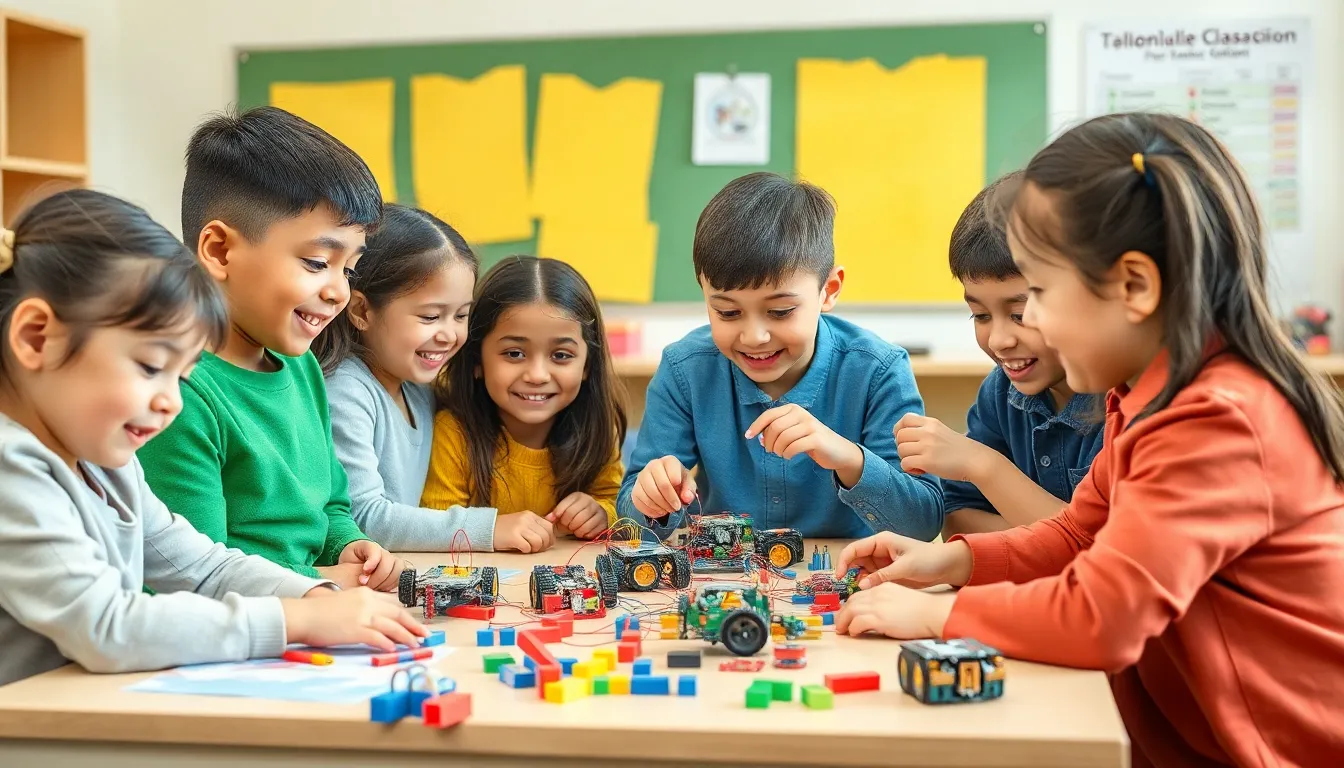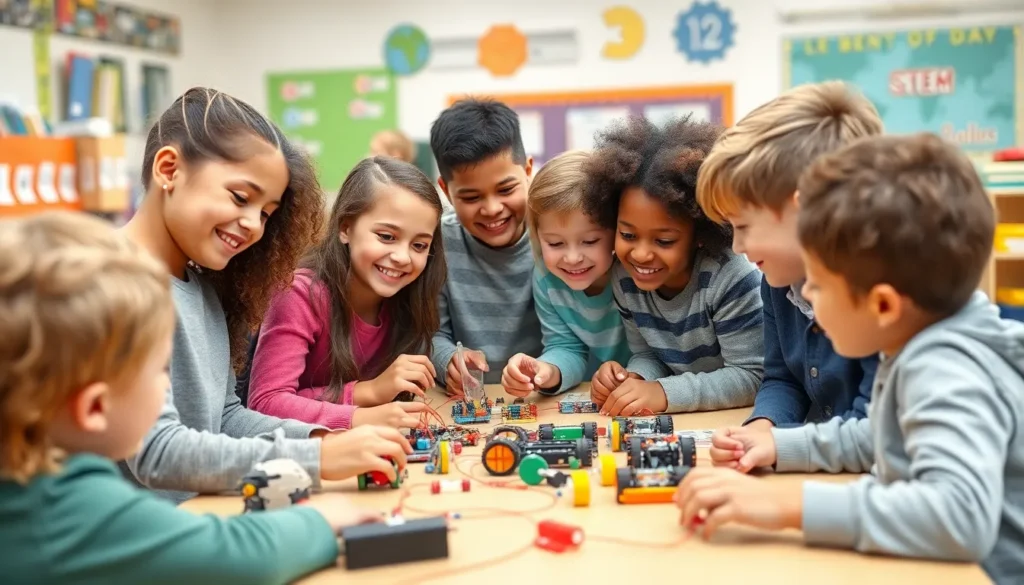STEM for kids isn’t just a buzzword; it’s a gateway to unleashing young minds into a world of creativity and innovation. Imagine a space where science, technology, engineering, and math come together like peanut butter and jelly—deliciously fun and oh-so-nutritious for the brain! With STEM, kids aren’t just learning; they’re embarking on thrilling adventures that spark curiosity and foster problem-solving skills.
Table of Contents
ToggleWhat Is STEM For Kids?
STEM for kids encompasses education focused on science, technology, engineering, and math. This approach engages children in hands-on learning experiences that develop critical skills. Through projects and activities, kids explore concepts such as coding, robotics, and environmental science, making lessons interactive and fun.
Learning in a STEM environment fosters creativity and innovation. Children collaborate on group projects, enhancing their teamwork and communication abilities. Problem-solving is a key aspect; kids tackle real-world challenges through experimentation and inquiry.
Teachers often incorporate games and engineering challenges into classroom activities. Using these methods, educators capture students’ interest while reinforcing academic subjects. Kids don’t merely absorb information; they engage with it, leading to deeper understanding.
Progress in STEM education can lead to increased interest in related career fields. When children see practical applications of their learning, their enthusiasm grows. Schools often host STEM fairs, allowing students to showcase projects and share knowledge with peers.
Parents play a crucial role in supporting STEM learning at home. Simple activities, such as building models or conducting experiments, stimulate curiosity and reinforce classroom experiences. Libraries also provide resources, including books and kits, aimed at young learners interested in STEM.
Engaging students in these subjects serves to prepare them for future opportunities. By emphasizing real-world relevance, STEM education paves the way for a generation of innovative thinkers.
Importance Of STEM Education

STEM education holds significant value for children’s development. It enhances essential skills and fosters innovative thinking.
Enhancing Critical Thinking Skills
Critical thinking thrives in a STEM-centric learning environment. Children learn to analyze problems from different angles and evaluate possible solutions. Engaging in hands-on activities encourages them to ask questions and determine effective answers. Class discussions often challenge assumptions, prompting deeper understanding. Exploring scientific methods allows kids to make observations and draw conclusions based on data. They develop logical reasoning by solving real-world problems, equipping them for future decision-making. Fostering these skills ensures that children adapt and excel in an ever-changing world.
Encouraging Creativity
Creativity flourishes through STEM activities. Students frequently explore concepts in a playful manner, blending imagination with factual knowledge. Engaging in project-based learning inspires them to think outside the box as they experiment with various ideas. Working on robotics or coding projects leads kids to innovate and implement original solutions. Collaborative group efforts enhance creative exchanges, as they share diverse perspectives. By embracing creativity in learning, children find joy in discovery and gain confidence in their abilities. This creativity lays the foundation for future explorations in various fields, encouraging lifelong learning.
Key Components Of STEM
STEM consists of four key components: science, technology, engineering, and mathematics. Each element contributes to a comprehensive educational approach that fosters critical thinking and creativity.
Science
Science encompasses the exploration of natural phenomena and the application of scientific principles. Children engage in hands-on experiments and observations to develop a deeper understanding of concepts such as biology, chemistry, and physics. Inquiry-driven projects allow kids to ask questions and analyze results, nurturing their curiosity and analytical skills. Learning through science fosters a commitment to asking “why” about the world around them, leading to thoughtful exploration and experimentation.
Technology
Technology integrates digital tools and resources into learning experiences. It includes coding, app development, and the use of various software programs. Students learn to navigate technology effectively, developing both practical skills and innovative approaches to problem-solving. Through interactive games and digital projects, children enhance their digital literacy and gain an appreciation for the role of technology in everyday life. Exposure to technology encourages adaptability and equips kids to succeed in an increasingly tech-driven world.
Engineering
Engineering involves the design and construction of solutions to real-world challenges. Children participate in engineering challenges that require teamwork and creative problem-solving. Projects may include building bridges, designing vehicles, or creating simple machines. These activities not only emphasize the engineering design process but also instill critical skills such as planning, testing, and improving designs. Engaging in engineering fosters confidence as students see their ideas materialize into tangible outcomes.
Mathematics
Mathematics serves as the foundation for understanding patterns and structures in both natural and technological environments. Kids explore concepts like geometry, algebra, and data analysis through practical applications. They learn to approach problems logically and quantitatively, enhancing their reasoning abilities. Collaborative activities, such as measuring dimensions or analyzing statistics, demonstrate the relevance of math in everyday situations. Emphasizing real-world contexts makes mathematics engaging and reinforces its importance in STEM fields.
Activities To Introduce STEM
STEM learning thrives on interactive activities. Engaging children in hands-on experiences enhances understanding and retention.
Hands-On Experiments
Kids experience science through hands-on experiments. Activities like growing crystals or building simple circuits capture their curiosity. Experimentation teaches them how theories apply to real life. By involving ingredients or tools, children develop a deeper understanding of scientific concepts. Projects often yield immediate results, providing instant gratification and reinforcing learning. Outcomes lead to discussions about hypotheses and results, encouraging critical thinking. Communities often organize science fairs, allowing kids to showcase their experiments, further motivating students to explore scientific ideas.
Educational Games
Educational games make learning enjoyable and impactful. Interactive apps or board games focus on mathematics and problem-solving, engaging students through fun challenges. Competitive elements in these games foster healthy rivalry while reinforcing concepts. Children develop teamwork skills as they collaborate to achieve shared goals. Learning through games allows kids to grasp fundamental concepts without the pressure of traditional assessments. Enrichment programs at schools sometimes include these games, igniting an excitement for STEM subjects. Such playful engagement results in a lasting interest in various STEM fields.
STEM education for kids is a vital pathway to developing essential skills and fostering creativity. By engaging in hands-on activities and collaborative projects, children not only grasp complex concepts but also cultivate a love for learning. This dynamic approach equips them with the tools to tackle real-world challenges confidently.
As children explore science, technology, engineering, and mathematics, they build a foundation for future innovations. The excitement of discovery and problem-solving prepares them for diverse career opportunities. With continued support from parents and educators, the journey through STEM can inspire a generation of thinkers and creators ready to shape the future.






